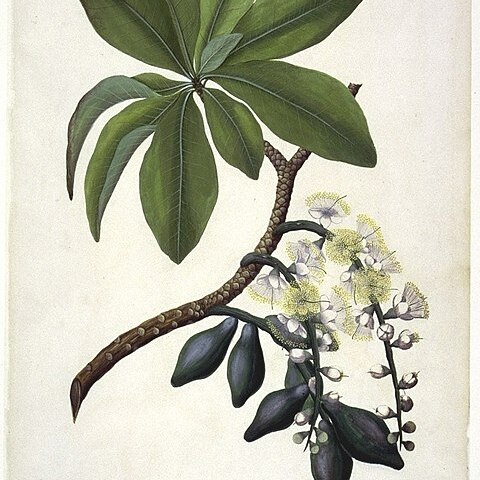Small to medium sized trees, 10-20 m tall, twigs 5-10 mm diam. Leaves grouped towards apex of branches; petioles 0.5-3 cm long, slightly swollen at base; lamina obovate-oblong, 10-29 by 4-13 cm, coriaceous, base cuneate, decurrent almost to base of petiole, margins entire, apex obtuse or rarely cuspidate, lower surface glabrous; midrib flattened prominulous above, prominent beneath, primary veins 8-20 pairs, brochidodromous, merging only through network of intercostal veins, prominulous above, prominent beneath, intercostal veins prominulous on both surfaces, reticulate. Cataphylls triangular, 2-5 by c. 2 mm. Inflorescences ramiflorous spikes, pendulous, 30-40 cm long, with up to 60 flowers, densely distributed; rachis 3-7 mm diam., densely fulvous or grey-green pulverulent; bracts sessile, lanceolate, 8-20 by c. 3 mm. Calyx closed in bud, apex rounded, pulverulent, rupturing into a circumscissile, caducous cap, 3-8 by 10-12 mm and a low slightly divided ring. Flowers sessile; hypanthium grooved, 3-4 by 3-4 mm, grey-green to fulvous pulverulent; petals 4-5, elliptic, 1.25-2.5 by 0.5-1.75 cm, red or white; stamens white, staminal whorls 4-5(-7), the inner 1-2 staminodal, staminal tube 2-3 mm high, staminodia connate up to 4-10 mm, free filiform part 2-5 mm, bent inwards against the style; disc 1-2 mm high; ovary (2-)3-4-locular, 2-4 ovules per locule; style 3-4.5 cm long, white. Fruits ovoid or spindle-shaped, 5-9.5 by 1.75-2.5 by 1.5-2.25 cm, truncate. Seeds subglobular, c. 2 by 1.5 cm.
More
Tree 10–30 m high, deciduous. Bark thick, furrowed, flaking. Leaves: lamina obovate-oblong to oblanceolate or ± narrowly elliptic, c. 15–39 cm long, 4–13 cm wide, cuneate at base, entire with distinct marginal vein, obtuse, cuspidate or emarginate at apex, glabrous; petiole 5–35 mm long. Oil leaves turn red prior to falling. Spikes cauliflorous, up to 60–flowered; bracts lanceolate, 8–20 mm long; bracteoles triangular, 2–3 mm long. Bud 7–12 mm long. Calyx circumscissile, the cap 3–8 mm long, leaving a rim 2–3 mm long, rarely calyx splitting to base into 4 irregular segments to 5 mm long and 10 mm wide (i.e. the calyx is completely fused at bud stage, then shed as a cap or sometimes ruptures to form lobes). Petals 4 or 5, elliptic, 10–30 mm long, white to pale yellow, sometimes green-tinged. Stamens numerous, in 4–7 whorls, the innermost 1 or 2 whorls sterile; tube 2–3 mm long; filaments 2–4 cm long, white; staminodes connate for 4–10 mm, the filaments 2–10 mm long. Ovary 2–4-locular, 3–4 mm long; ovules 2–4 per locule; style 3–7.5 cm long. Fruit ovoid to fusiform, 5–9.5 cm long, 4–6.5 cm wide, green to bluish, somewhat glaucous, ± fleshy when ripe. Seed 1, broadly ellipsoidal, c. 2 cm long.


